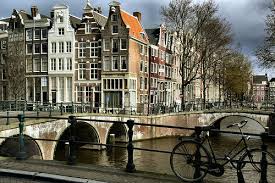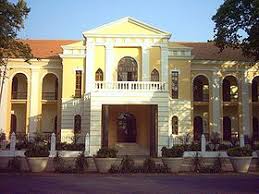
The attempt to revive the creek
that runs through Campal and Tonca, and sometimes erroneously called ‘Campal
Creek’ is one of the many urban regeneration projects that animates Panjim’s
citizens these days. This is a happy occurrence and we must all hope that the
initiative will come to fruition. An earlier reflection on this column had
observed that what marked Indo-Portuguese architecture, was not merely an
interaction between Goa and Portugal, but in fact
an interaction by Goa with Europe. In this context then, the inspiration that Amsterdam’s canals and
bridges provide to the Campal Creek project is a continuation of this longer
tradition. Given that the project is being led by citizens from the generally
more well-to-do area of Campal, the project continues another tradition, in
this case the Dutch tradition where the canals of Amsterdam were the product of
an active initiative of the Dutch elites of centuries past.

However, what we need to also
remember that Amsterdam, and its pretty canals and bridges were not always this
pretty. On the contrary, for a very, very long time, and until fairly recently,
the canals of the city were receptacles for the city’s sewage. Indeed, it was
only in 1987 that the last house to send its sewage into the canals was
connected to a sewerage system. What is important to note then, is that the
Amsterdam project, if one can put it that way, is a continuing one. What is
also important to note, is that this project was not motivated by the
possibility of gaining tourist visits to the city. Rather, it was motivated by
making the city more livable, providing a better quality–of-life to its
citizens. Thus, in addition to the joy rides that tourists may enjoy on the
canals, and walking around the streets, the canals are also used as a source of
regular transport for its citizens.

This location of the citizen, rather
than the tourist, is important for us to bear in mind in the course of engaging
not only with urban regeneration projects, but also the variety of heritage
restoration projects that one sees around our State.

This observation holds particular
importance in the context of the recent completion of the restoration of the
Reis Magos fort. In the past few years there have been a number of restoration
works that have been carried out on heritage buildings that are the property of
the State. These include the Forts at Tiracol, Reis Magos, Santo Estevam, as
well as the premises of the former
Escola Medica. A news
report in the Times of India on May 31
pointed out that the Government does not seem to have a policy that would cover
adaptive reuse of heritage structures that belong to the State. A number of
people, especially those intimately involved with heritage conservation, make
the argument for adaptive reuse, stressing at the same time the need for
“revenue generation through cultural tourism”.
Regardless of whether it is linked to cultural tourism or not, what has
to be recognized is that once the question of the decay of the monument has
been addressed, the issue of generating resources for its upkeep become
important.

The question however, is to
inquire into the manner in which the resources for this requirement will be
generated. This is where the question of choice, between placing the citizen or
the tourist, at the heart of the project comes into being. Given the manner in
which tourism is such a critical part of the Goan economy, all too often
tourism, cultural or otherwise, becomes a focus of our options for adaptive
reuse. In this context, the words of the Chief Minister are somewhat
disturbing. He is
reported to have indicated that “the fort would have to find
a way to make itself commercially viable” indicating that "The government
is good at building, not maintaining." It was perhaps under similar logic
that the location of a mall-shopping arcade was contemplated within the
refurbished
Escola Medica.

We must recognize however, that
such logic is indication of an abdication of the responsibilities of the State,
creating the grounds for the privatization of public resources. The argument
that this column would make, an argument that is perhaps not different from
those others in the heritage conservation groups are also making, is that it is
possible for the monument to address the local community first, and
simultaneously also address the larger interests of cultural tourism in the
State.

It is in this context that
Amsterdam in particular, and Europe in general can be used as an interesting case
to learn from. Social spending, in catering to the citizen, educating them, and
opening cultural options for them, is what simultaneously generates the options
for cultural tourism. It was not catering to the tourist that generated its
prettiness, but catering to the citizen first. Even though the
European economy is now in crisis, it must be pointed out that this crisis should not be used to
suggest that the model of social spending was the problem. On the contrary, to
use the
words from The New Yorker
“social democracy in Europe, embodied by its union, has been one of the
greatest successes in history.” And further “A continent torn by the two most
horrible wars in history achieved a remarkable half century of peace and
prosperity, based on a marriage of liberalism properly so called (individual
freedoms, including the entrepreneurial kind) and socialism rightly so ordered
(as an equitable care for the common good). Any pleasure taken in the failure
of Europe to expunge all its demons threatens to become one more way of not
having to examine our own.”

This advice was given to the USA,
however, we in India, with our elitist biases in the working of democracy would
do well to take heed and find the governmental resources to support adaptive
reuse the works to make refurbished monuments, locations for the edification
and personal growth of our citizens. This would only work as a wise investment,
creating citizens who would be able to spin more creative concepts than perhaps
the less-challenged governmental departments in charge of tourism. Such an
option need not necessarily preclude entrepreneurial intervention, but we must
be clear that high-end malls and boutique hotels do not seem to constitute the
kinds of projects that can meet this larger end, given that they actively
exclude, even as they may generate some revenue for the State. What we must
bear in mind however, is that these investments should be evaluated not merely
for commercial viability, but from the kind of human-resource generation that
they provide.
In welcoming the Reis Magos fort
back to life, and wishing the Campal project a similar trajectory, perhaps we
should also make space for the citizen at the centre of our plans, and not only
the tourist.
(A version of this post was first published in the Gomantak Times 13 June 2012)

No comments:
Post a Comment